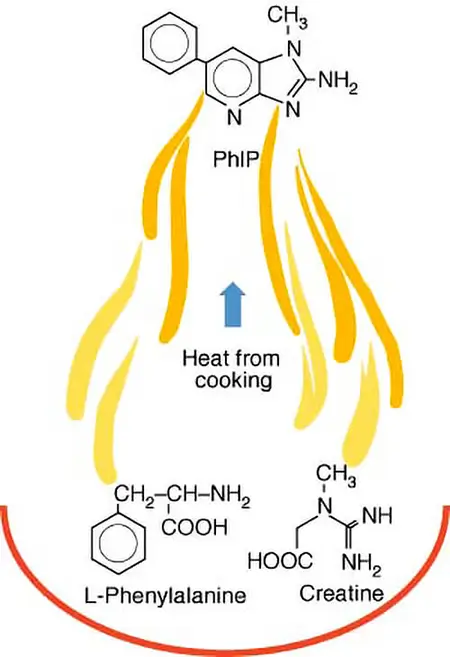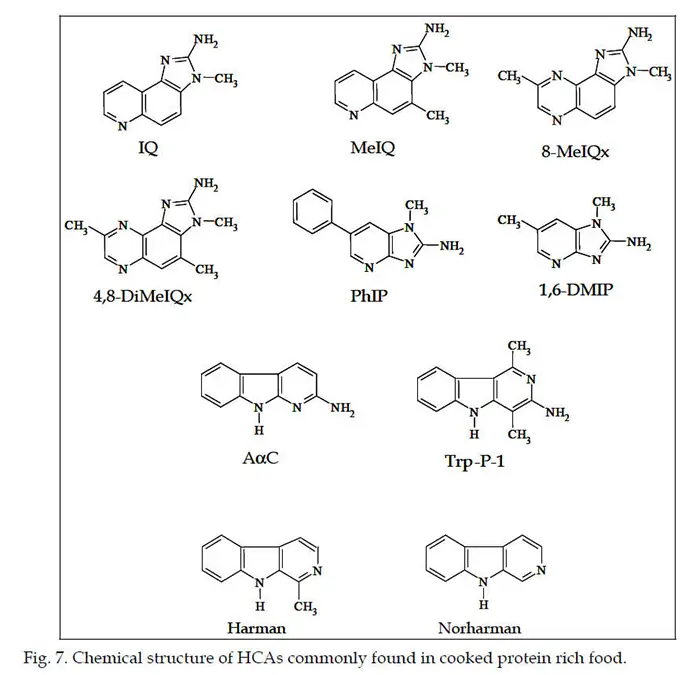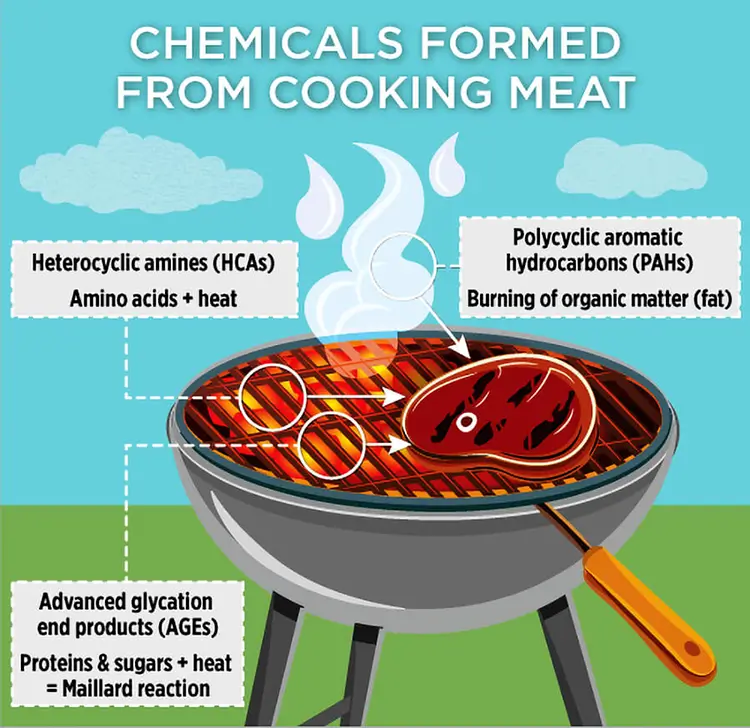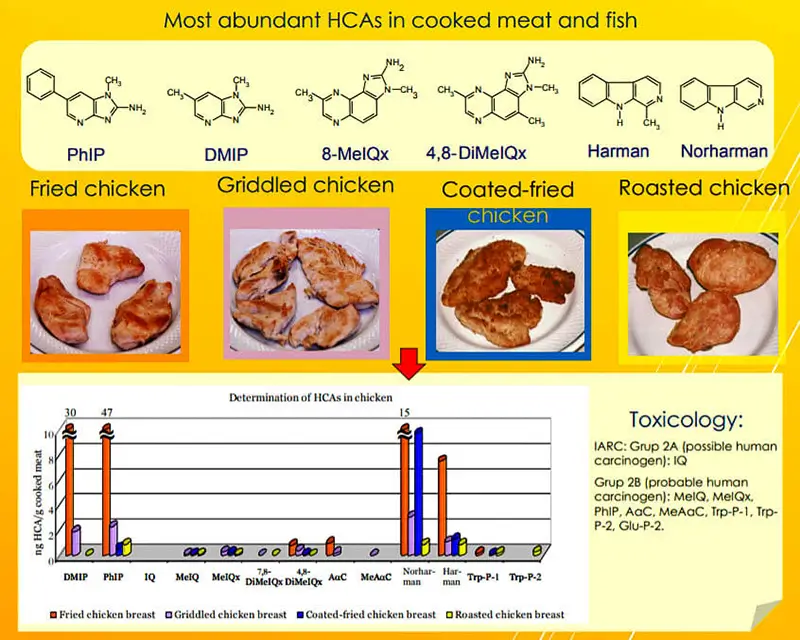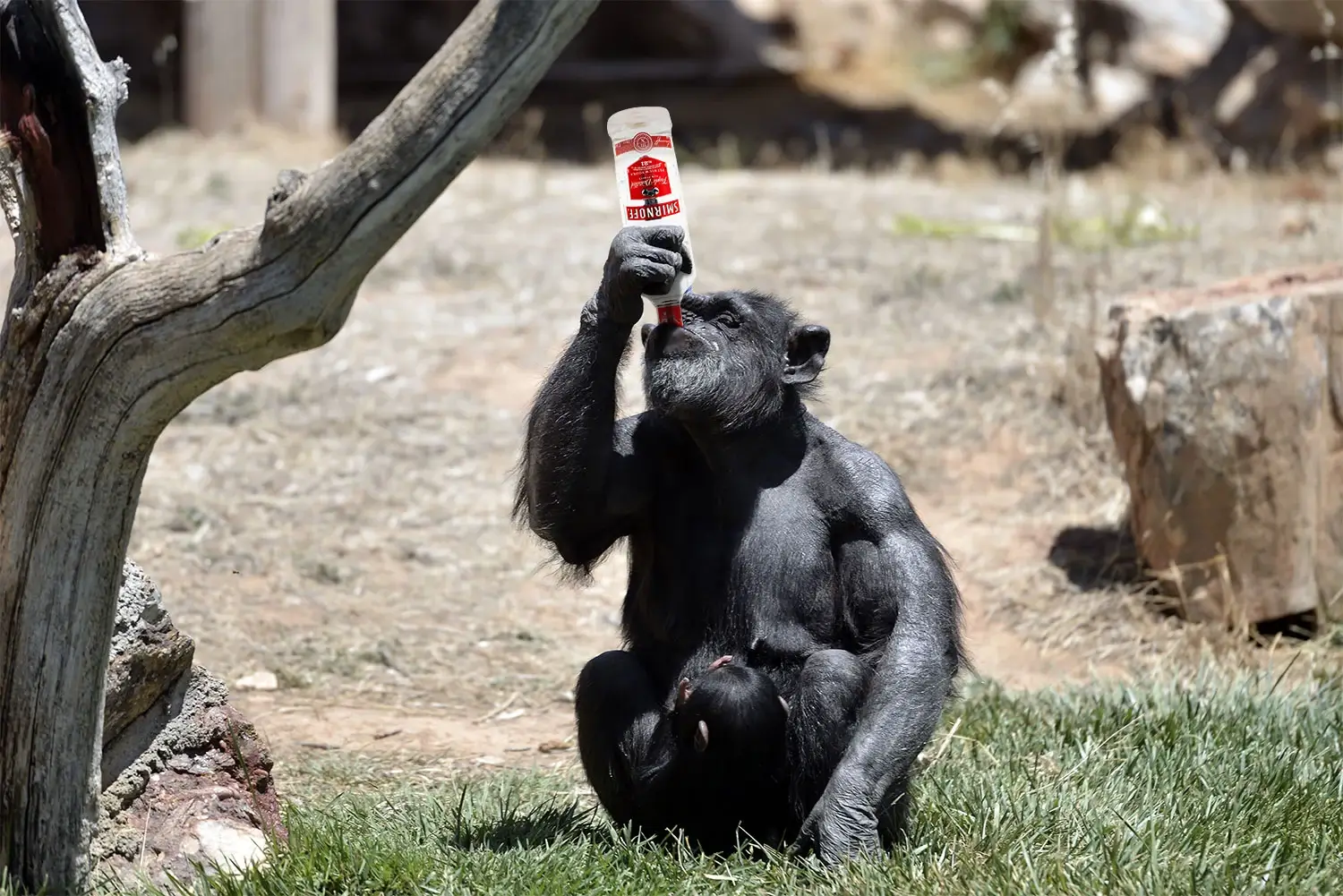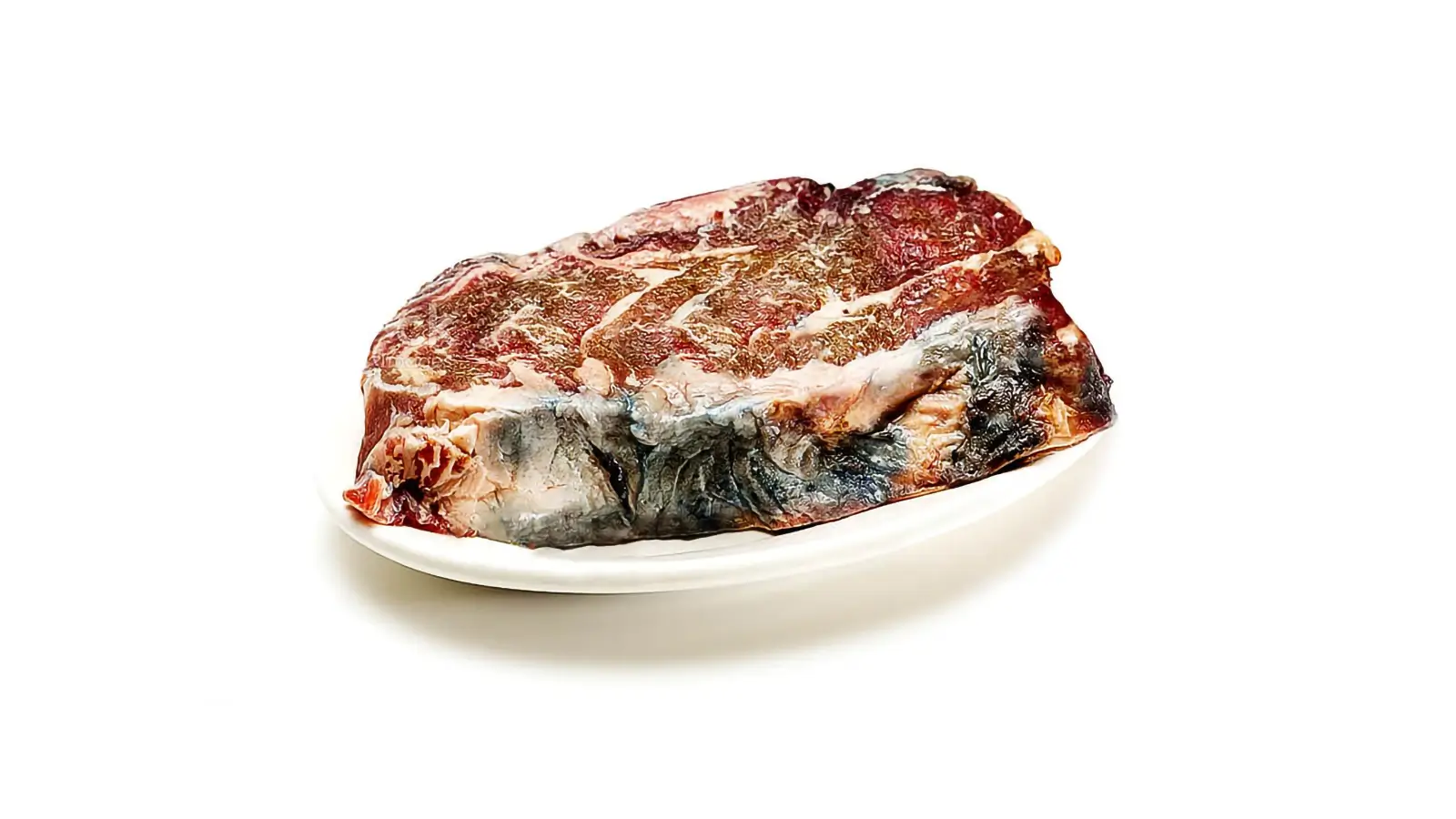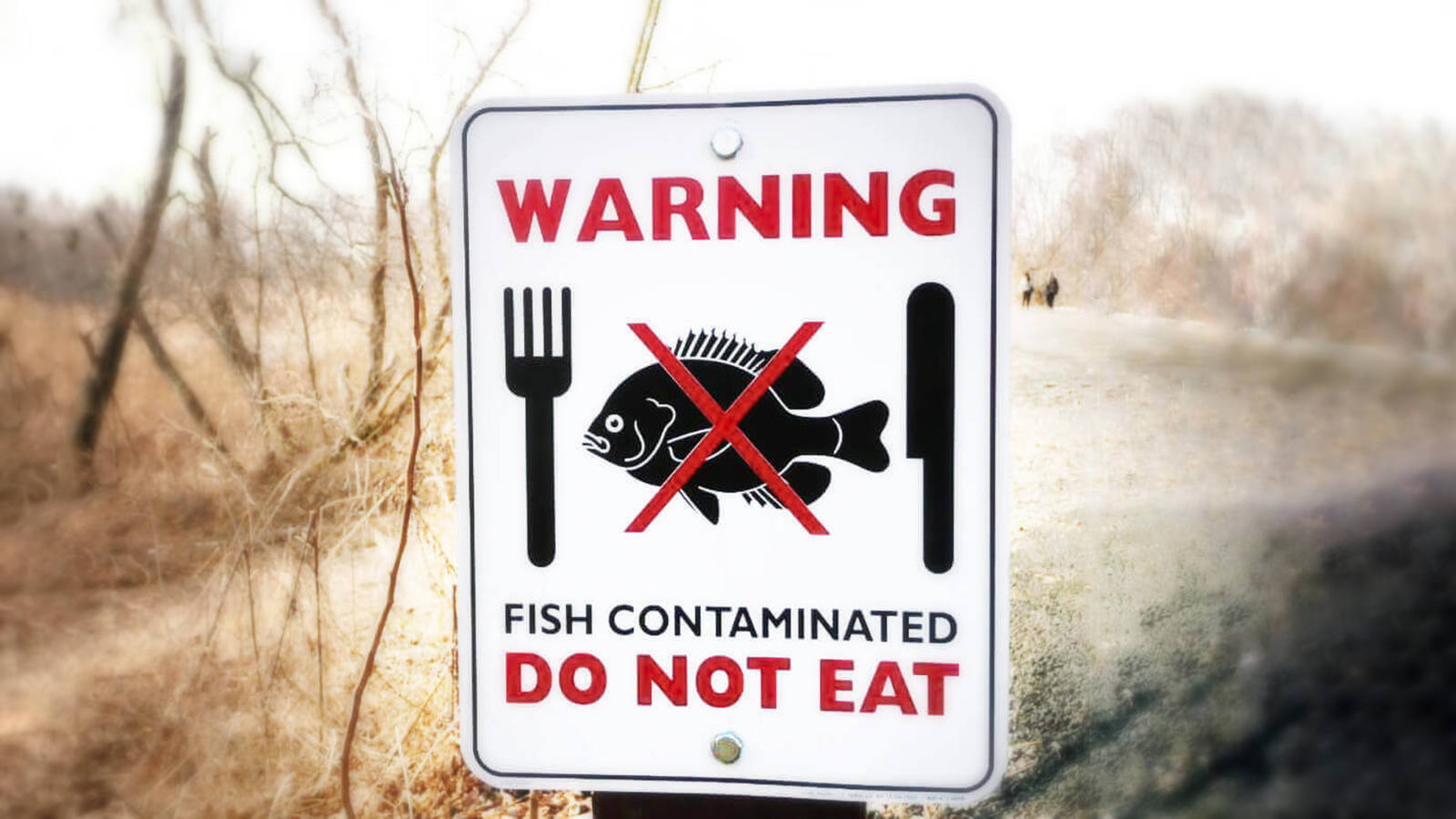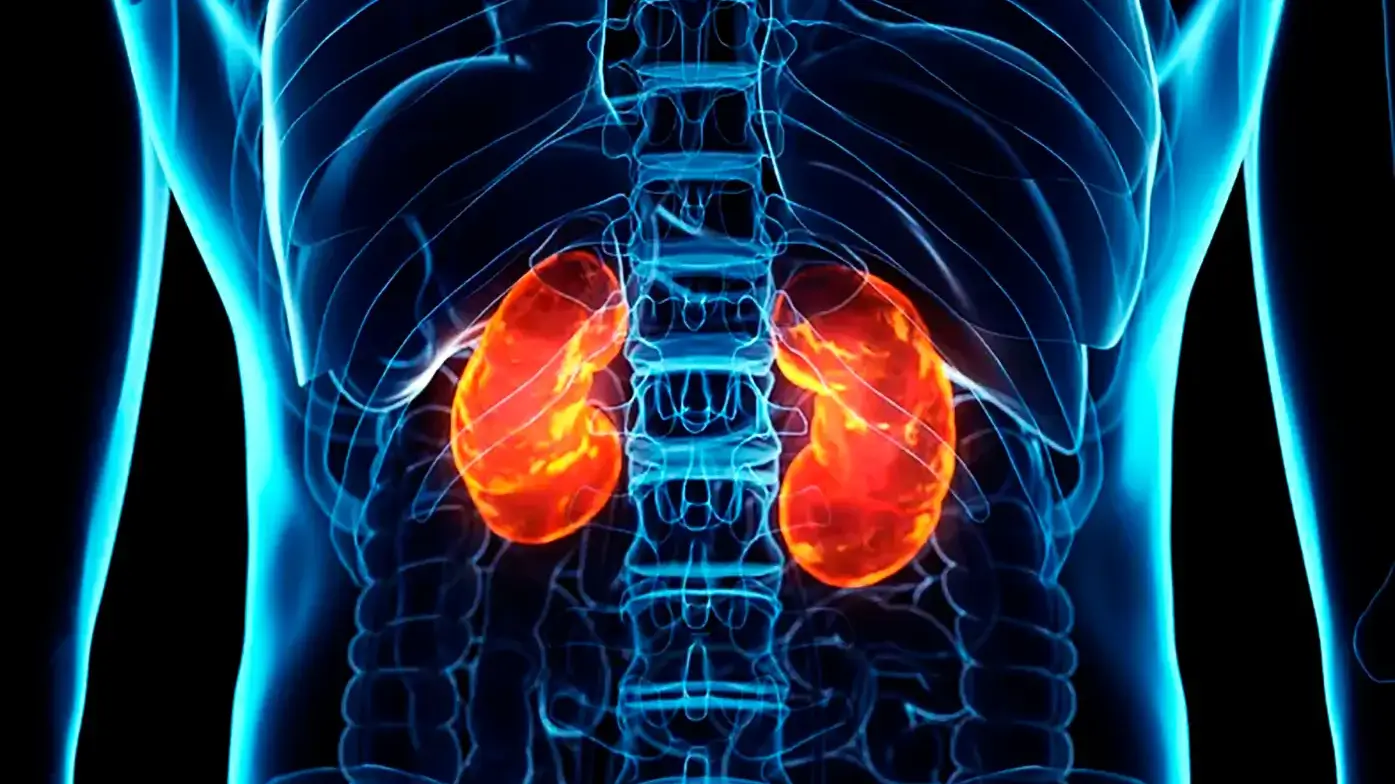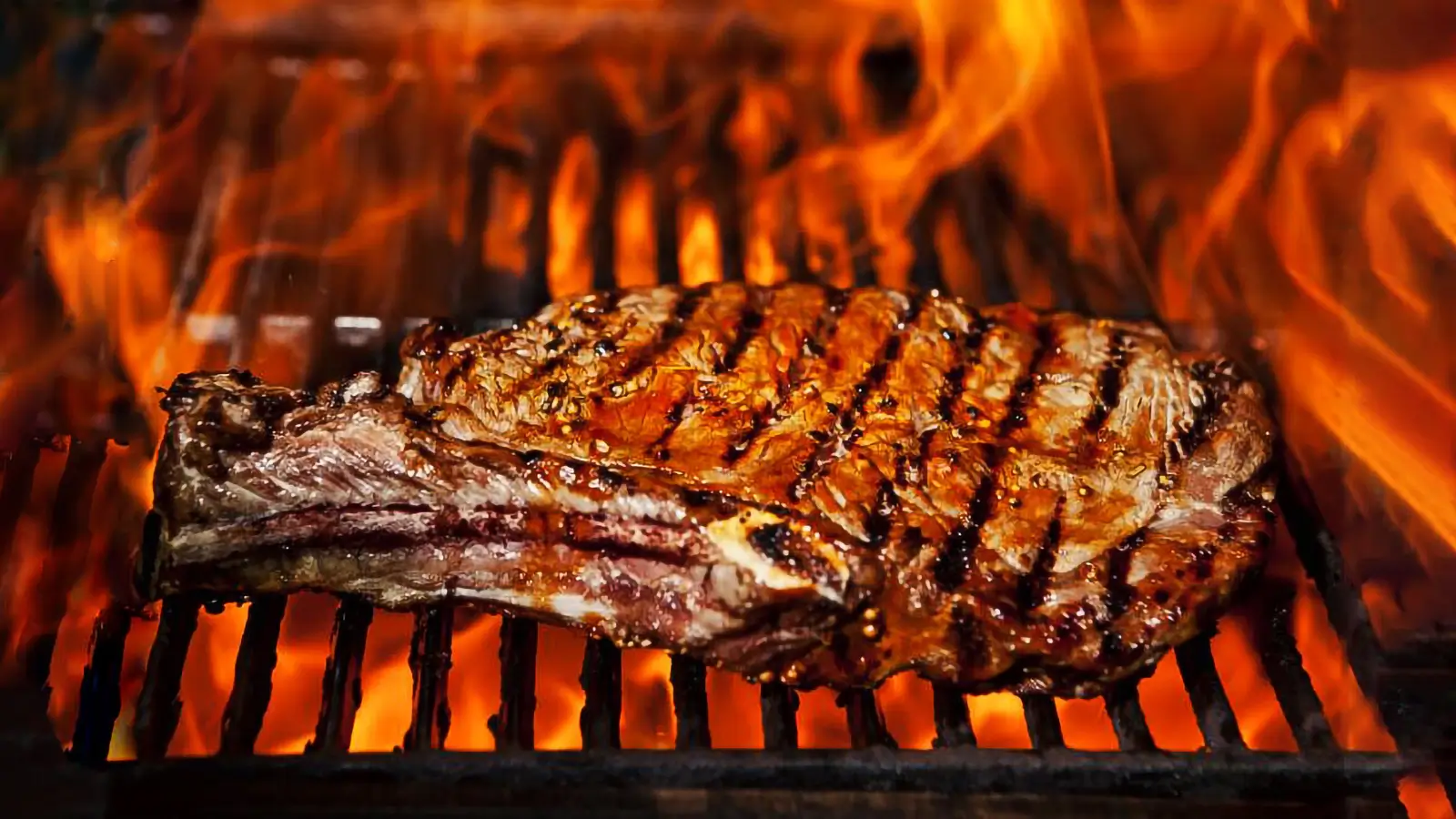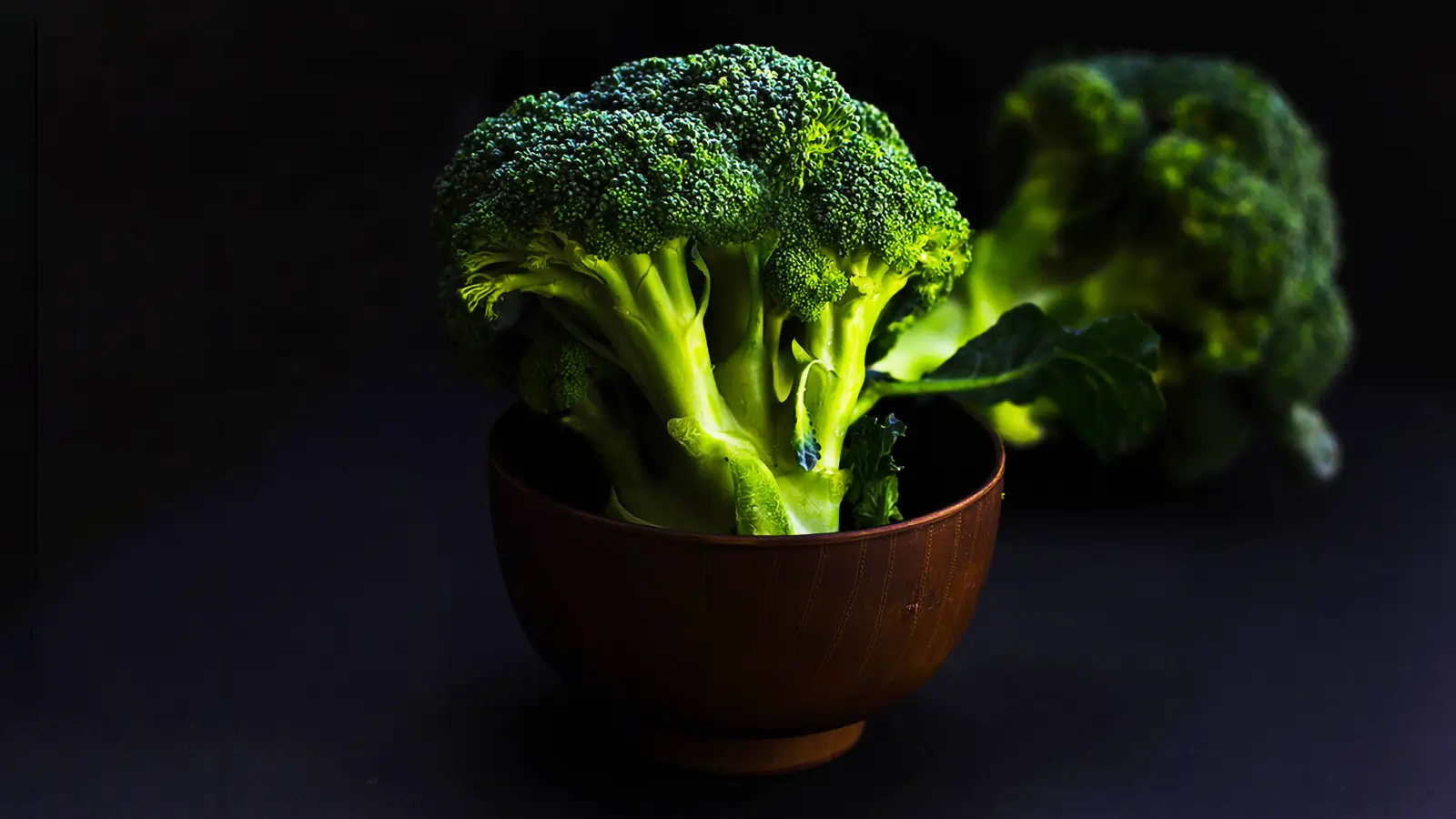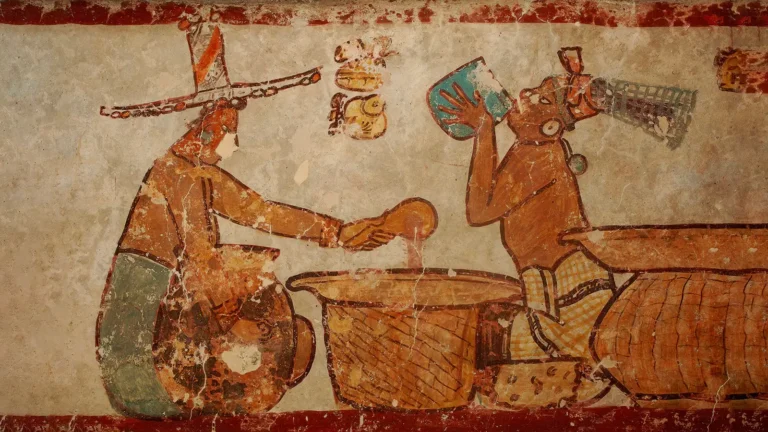Cooked Meat- The Mutagen in a Bite, Heterocyclic Amine Exposure
Heating of amino acids in the presence of creatine (cooked meat) creates mutagens known as Heterocyclic Amines (HCA).
Milos Pokimica
Written By: Milos Pokimica
Medically Reviewed by: Dr. Xiùying Wáng, M.D.
Updated June 9, 2023There is no known animal in nature except modern humans that grills meat. This is not an evolutionary congruent process that is causing serious maladaptation.
Heating of amino acids in the presence of creatine and monosaccharide sugars creates mutagens known as Heterocyclic Amines (HCA). Our body does not recognize them as different and integrates them into the cells. These amino acids have been damaged due to heating and their molecular form is changed. This integration into healthy cells causes mutations in DNA. Cancer is one of many correlated diseases.

Paleo people who like lean meat somehow forget that in the Paleo period most prehistoric people did not live long enough to die from cardiovascular disease or cancer or suffer from chronic diseases. In extremely harsh conditions where the average life expectancy is 32 years of age, the genes that get passed along to younger generations are the ones that are just old enough to go to reproductive age by any means necessary. That means not dying of starvation or disease or in an attack. The more calories we consume, the better no matter what they are. The meat cancer link is not really of any concern.
Eating raw meat from decaying carcasses is not our food. It would take just a couple of hours after death in climate conditions in Africa for meat to spoil.
Carnivorous species deal with bad microorganisms with strong stomach acid. The capacity of the carnivore stomach to emit hydrochloric acid is outstanding. Carnivores can hold their gastric pH all way down to around 1 or 2, even with food present. Strong gastric pH facilitates protein breakdown and is necessary to kill the abundant amount of dangerous microorganisms frequently found in rotting flesh. Their digestive tract is sterile and there is no large colon for fermenting fiber or other foods. Meat is digested in a couple of hours and excreted out. In carnivore animals, transit time is very short. Types of bacteria in the intestine are different also. When we eat a rotten apple, we might get drunk, but if we eat raw decaying flesh, there is an excellent possibility of severe consequences and death.
In certain conditions when there is an absolute need, the herbivorous animals will eat available meat only to survive. And the meat has to be cooked.
Let me give one example of how chronic diseases occur and progress so that we can start to understand this. The most common nervous system disorder of all neurological disorders is something called essential tremor (ET). It usually involves an involuntary shaking of the arms, hands, or fingers but sometimes it can also affect the head, vocal cords, or other body parts. It is a different condition than Parkinson’s disease but is often misdiagnosed as such. In most severe cases, ET interferes with a person’s activities of daily living, like dressing, taking care of personal hygiene, feeding, and is generally progressive in most cases. Some people have it in families so genetics plays a role and will develop symptoms at an early age but it is not bad genetics that is the real problem, and I will explain.
What happens is that when we heat amino acids (building blocks of protein) in the presence of creatine and monosaccharide sugars, they have a reaction and amino acids lose their molecular form.
What that means is that they are different but not that much, and that is the problem because our body does not recognize them as different. It thinks that they are just regular aminos. Meat cancer is a correlation caused by this mutagenicity of Heterocyclic Amines (HCA) but so are many other different conditions.
We are still not fully adapted to our new lifestyle and as a consequence what happens is that they start to be incorporated into our cells. Because their molecular structure is different, it causes problems in the form of mutations. Having mutations maybe sound like a good idea for an SF movie, but in real life it kills.
It causes changes to DNA. Meat heated at high temperatures, especially above 300 °F (as in grilling or pan-frying), or that is cooked for a long time, tends to form more of these mutated heterocyclic amines (HCAs).
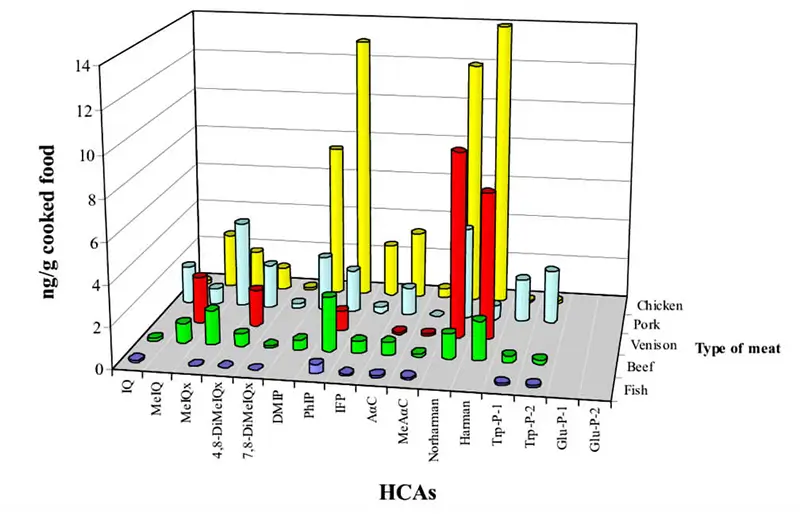
For example, well done, grilled, or barbecued chicken and steak all have extreme concentrations of Heterocyclic Amines (HCAs). Chicken is the worst of them all actually, with around two times more of this carcinogen than beef or pork. Marinating meat before cooking in some form of antioxidant-rich marinades like garlic or rosemary seems to help. Garlic at 20 gm/100 gm marinade reduced carcinogen production by about 70%. In contrast, regular barbecue sauce that contains much sugar caused a significant increase in chemical formation, tripling the levels after 15 minutes of cooking.
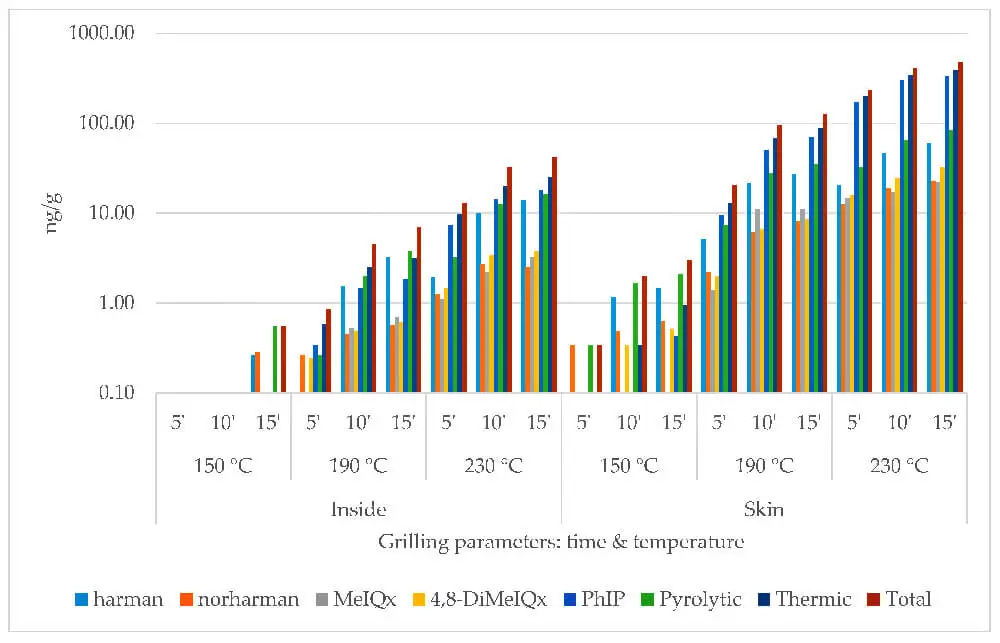
There is a list of different types of these messed-up heterocyclic Amines in cooked meat that are created. PhIP (2-Amino-1-methyl-6-phenylimidazopyridine) is the most abundant one. Long-term rodent studies confirmed that PhIP causes mammary gland and colon cancer. The most toxic and mutagenic of all is MeIQ. MeIQ is precisely 24 times more carcinogenic than aflatoxin, and aflatoxin is one of the most toxic substances ever created by mold. All of the other ones, and there are more than 20 HCAs, are more toxic than benzopyrene. Benzopyrene is a primary carcinogen that does the most damage in smokers and is found in cigarette smoke and coal tar.
Smoke actually at the same time during cooking creates a list of other different mutagens named polycyclic aromatic hydrocarbons (PAHs). Cooking techniques that expose meat to smoke or charring contribute to PAH formation. PAHs are created with the high-temperature cooking of meat. For example, when fat and juices from grilled meat drip and cause flames, the fumes will be filled with PAHs that will then adhere to the surface of the meat. Any form of burning can create them, for example, coal, oil, gas, wood, garbage, and tobacco have them too. They are also formed where smoke is used such as smoking of meats.
These unnatural mutagens (HCAs and PAHs) that are formed with unnatural activities such as grilling are capable of damaging DNA because of our lack of adaptation to them. The body has a line of specific enzymes to neutralize these mutagens.
Researchers have discovered that the action of those enzymes differs significantly among people. And that is a problem. In individuals who have lower levels of these enzymes, exposure to these compounds may be associated with an increase in cancer risks. Some of us can cope better with detoxifying these mutagens and some can’t and will have a higher risk of cancer. And that is what is called a genetic factor in medicine. It is not that we are born with bad genes, and that is it, you will get cancer or you will not. The situation is more complicated than that.
Of course, some level of cancer happens in animals too, but 23.4% of all deaths are not from genetics. It is an epidemic of biblical proportions because it is, in essence, a form of maladaptation to our environment.
One of the HCAs that is formed is Harmane. Harmane is a neurotoxin that is strongly associated with essential tremors. If exposed by injection mouse will develop an extreme tremor in just 3.1 minutes after the exposure and the tremor would last for hours. Because it is fat-soluble, it will accumulate over time in all fat tissues including the brain. It is found in elevated levels not just in the brains of ET patients but also in Parkinson’s disease. When compared to the control group Harmane concentration is precisely 50 percent higher in the brains of essential tremor patients. It is also elevated in blood samples too. If there is a patient that has a family history of essential tremor blood work results show the highest concentrations of all people.
Essential tremor is liver enzyme detoxification disease, a form of maladaptation. People with ET but without a family history will have little lower levels than people with a family history but still well above normal levels. Elevated Harmane in ET is due to an inherited reduction in the capacity to metabolize it out of the system. Same with any other disease, some people are more prone to it some less, but none of us are immune completely. That is why we see that with time the percentage of people with the disease goes up. From 4% in the 40s to 20% in the 90s. If we managed to live long enough most of us will eventually get it, except for the people who do not consume it. For each additional 10 grams/day of meat consumed, the odds of ET are increased by 6%.
Now you might not get ET, all of this is a just small example for logical understanding. You might just get cancer. The real difficulty is that there is a long list of different chronic diseases to make a pick from depending on individual genetics.
References:
Passages selected from a book: Pokimica, Milos. Go Vegan? Review of Science Part 1. Kindle ed., Amazon, 2018.
- Hopfner, Franziska, and Rick C. Helmich. “The Etiology of Essential Tremor: Genes Versus Environment.” Parkinsonism & Related Disorders, vol. 46, Elsevier BV, Jan. 2018, pp. S92–96. https://doi.org/10.1016/j.parkreldis.2017.07.014.
- Louis, Elan D et al. “Dietary epidemiology of essential tremor: meat consumption and meat cooking practices.” Neuroepidemiology vol. 30,3 (2008): 161-6. doi:10.1159/000122333
- Barzegar, Fatemeh et al. “Heterocyclic aromatic amines in cooked food: A review on formation, health risk-toxicology and their analytical techniques.” Food chemistry vol. 280 (2019): 240-254. doi:10.1016/j.foodchem.2018.12.058
- Sanz-Serrano, J et al. “Genotoxicity evaluation of fried meat: A comprehensive review.” Food and chemical toxicology : an international journal published for the British Industrial Biological Research Association vol. 136 (2020): 110943. doi:10.1016/j.fct.2019.110943
- Felton, J S et al. “Identification of the mutagens in cooked beef.” Environmental health perspectives vol. 67 (1986): 17-24. doi:10.1289/ehp.866717
- Heddle, J A et al. “A test of the mutagenicity of cooked meats in vivo.” Mutagenesis vol. 16,2 (2001): 103-7. doi:10.1093/mutage/16.2.103
- Shin, Aesun et al. “Meat and meat-mutagen intake, doneness preference and the risk of colorectal polyps: the Tennessee Colorectal Polyp Study.” International journal of cancer vol. 121,1 (2007): 136-42. doi:10.1002/ijc.22664
- Shabbir, Muhammad Asim et al. “Effect of thermal treatment on meat proteins with special reference to heterocyclic aromatic amines (HAAs).” Critical reviews in food science and nutrition vol. 55,1 (2015): 82-93. doi:10.1080/10408398.2011.647122
- Alaejos, M S et al. “Exposure to heterocyclic aromatic amines from the consumption of cooked red meat and its effect on human cancer risk: a review.” Food additives & contaminants. Part A, Chemistry, analysis, control, exposure & risk assessment vol. 25,1 (2008): 2-24. doi:10.1080/02652030701474235
- Pleva, Dániel et al. “Predictive Correlation between Apparent Sensory Properties and the Formation of Heterocyclic Amines in Chicken Breast as a Function of Grilling Temperature and Time.” Foods (Basel, Switzerland) vol. 9,4 412. 2 Apr. 2020, doi:10.3390/foods9040412
- Zheng, Wei, and Sang-Ah Lee. “Well-done meat intake, heterocyclic amine exposure, and cancer risk.” Nutrition and cancer vol. 61,4 (2009): 437-46. doi:10.1080/01635580802710741
Related Posts
Do you have any questions about nutrition and health?
I would love to hear from you and answer them in my next post. I appreciate your input and opinion and I look forward to hearing from you soon. I also invite you to follow us on Facebook, Instagram, and Pinterest for more diet, nutrition, and health content. You can leave a comment there and connect with other health enthusiasts, share your tips and experiences, and get support and encouragement from our team and community.
I hope that this post was informative and enjoyable for you and that you are prepared to apply the insights you learned. If you found this post helpful, please share it with your friends and family who might also benefit from it. You never know who might need some guidance and support on their health journey.
– You Might Also Like –

Learn About Nutrition
Milos Pokimica is a doctor of natural medicine, clinical nutritionist, medical health and nutrition writer, and nutritional science advisor. Author of the book series Go Vegan? Review of Science, he also operates the natural health website GoVeganWay.com
Medical Disclaimer
GoVeganWay.com brings you reviews of the latest nutrition and health-related research. The information provided represents the personal opinion of the author and is not intended nor implied to be a substitute for professional medical advice, diagnosis, or treatment. The information provided is for informational purposes only and is not intended to serve as a substitute for the consultation, diagnosis, and/or medical treatment of a qualified physician or healthcare provider.NEVER DISREGARD PROFESSIONAL MEDICAL ADVICE OR DELAY SEEKING MEDICAL TREATMENT BECAUSE OF SOMETHING YOU HAVE READ ON OR ACCESSED THROUGH GoVeganWay.com
NEVER APPLY ANY LIFESTYLE CHANGES OR ANY CHANGES AT ALL AS A CONSEQUENCE OF SOMETHING YOU HAVE READ IN GoVeganWay.com BEFORE CONSULTING LICENCED MEDICAL PRACTITIONER.
In the event of a medical emergency, call a doctor or 911 immediately. GoVeganWay.com does not recommend or endorse any specific groups, organizations, tests, physicians, products, procedures, opinions, or other information that may be mentioned inside.
Editor Picks –
Milos Pokimica is a health and nutrition writer and nutritional science advisor. Author of the book series Go Vegan? Review of Science, he also operates the natural health website GoVeganWay.com
Latest Articles –
Top Health News — ScienceDaily
- Scientists find a safer way for opioids to relieve painon January 6, 2026
Researchers at USF Health have discovered a new way opioid receptors can work that may lead to safer pain medications. Their findings show that certain experimental compounds can amplify pain relief without intensifying dangerous side effects like suppressed breathing. This research offers a fresh blueprint for designing opioids that last longer, work better, and pose fewer risks. It also opens doors to safer treatments for other brain disorders.
- Why multiple sclerosis slowly steals balance and movementon January 6, 2026
Many people with multiple sclerosis struggle with balance and coordination, and this study uncovers a hidden reason why. Researchers found that inflammation in the brain disrupts the energy supply of vital movement-controlling neurons. As their mitochondria fail, these cells weaken and eventually die, worsening motor problems over time. Protecting brain energy systems could open the door to slowing these symptoms.
- A simple drug pair may succeed where liver fibrosis treatments failedon January 6, 2026
Scientists have found that combining silybin with carvedilol works far better against liver fibrosis than either drug alone. The duo targets the root drivers of liver scarring, sharply reducing collagen buildup and liver damage in experimental models. Importantly, both drugs are already approved and commonly prescribed. That makes this discovery especially promising for rapid clinical translation.
- Scientists discover “migrions,” a viral shortcut that supercharges infectionon January 6, 2026
Scientists have uncovered a surprising viral shortcut that turns moving cells into delivery vehicles for infection. Instead of spreading one virus at a time, infected cells bundle viral material into large structures called Migrions and pass them directly to new cells. This collective delivery jump-starts viral replication and boosts disease severity. The finding reveals a migration-based route of viral spread that defies classic models of infection.
- Flu drug once blamed for seizures in kids gets a surprising reversalon January 6, 2026
A long-running debate over Tamiflu’s safety in children may finally be settled. Researchers found that influenza, not the antiviral medication, was linked to serious neuropsychiatric events like seizures and hallucinations. Even more striking, kids treated with Tamiflu had about half the risk of these events compared to untreated children with the flu. The results suggest the drug may be protective rather than harmful.
- Nearly all women in STEM secretly feel like impostorson January 6, 2026
Nearly all women in STEM graduate programs report feeling like impostors, despite strong evidence of success. This mindset leads many to dismiss their achievements as luck and fear being “found out.” Research links impostorism to worse mental health, higher burnout, and increased thoughts of dropping out. Supportive environments and shifting beliefs about intelligence may help break the cycle.
- Think you make 200 food choices a day? Think againon January 5, 2026
The idea that we make over 200 unconscious food choices a day has been repeated for years, but new research shows the number is more illusion than insight. The famous figure comes from a counting method that unintentionally exaggerates how many decisions people really make. Researchers warn that framing eating as mostly “mindless” can undermine confidence and self-control. A more realistic view focuses on meaningful choices—and practical strategies that make healthy decisions easier.
PubMed, #vegan-diet –
- Response to Letter to the Editor: Iron, zinc, and iodine in vegan youthon January 4, 2026
No abstract
- Impact of alpha-linolenic acid supplementation on long-chain n-3 fatty acid profiles in Western, flexitarian, vegetarian, and vegan dietson December 31, 2025
CONCLUSION: In conclusion, flaxseed oil supplementation combined with a controlled diet effectively improves n-3 LCPUFA status irrespective of habitual diet. The extent of relative improvement was primarily determined by baseline EPA concentrations.
- Vegetarian Dietary Patterns for Adults: A Position Paper of the Academy of Nutrition and Dieteticson December 31, 2025
It is the position of the Academy of Nutrition and Dietetics that, in adults, appropriately planned vegetarian and vegan dietary patterns can be nutritionally adequate and can offer long-term health benefits such as improving several health outcomes associated with cardiometabolic diseases. Vegetarian dietary patterns exclude meat, poultry, and seafood, and vegan dietary patterns exclude all foods of animal origin. Registered dietitian nutritionists (RDNs) and nutrition and dietetics…
- Academy of Nutrition and Dietetics’ Vegetarian Position Paper Mistakenly Links Vegetarian and Vegan Diets with Vitamin D Deficiencyon December 31, 2025
No abstract
- The effect of a vegan diet with or without resistance exercise on thigh muscle volume in older adults. Research protocol of the Vold-study: a 12-week randomized controlled trialon December 26, 2025
BACKGROUND: Plant-based diets are increasingly adopted. Plant-based foods exhibit a lower protein quantity and quality compared to animal-based foods. As such, a fully plant-based, i.e. vegan, diet may be suboptimal for the maintenance of skeletal muscle mass later in life. The primary objectives of this study protocol are therefore: (1) To assess the effect of a 12-week self-composed vegan diet in comparison to an omnivorous diet on thigh muscle volume in community-dwelling older adults; and…
Random Posts –
Featured Posts –
Latest from PubMed, #plant-based diet –
- Parent Perspectives on the Interactive Role of Charitable and Federal Nutrition Assistanceby Cristina M Gago on January 6, 2026
CONCLUSIONS: The experiences of pantry users with children underscore the need to reinvest in charitable and federal nutrition assistance programs, broaden the eligibility criteria, and alleviate the administrative burden associated with federal nutrition program access.
- Enhancing Gluten-Free Cake Quality With Germinated and Ungerminated Mung Bean Flours: A Comparative Analysisby Sultan Acun on January 6, 2026
Gluten-free (GF) baked products are often constrained by limited nutritional quality and a lack of bioactive compounds. This study investigates the incorporation of germinated mung bean flours (GMBF) and ungerminated mung bean flours (UMBF) into GF cake formulations as partial (50%) or complete (100%) substitutes for rice flour. Comprehensive analyses were conducted on both cakes and raw flours, including proximate composition, total phenolic content (TPC), antioxidant activity…
- Quality-oriented diet therapy for chronic kidney diseaseby Juan J Carrero on January 6, 2026
Traditional dietary advice for people living with chronic kidney disease (CKD) focused predominantly on the quantity of energy and protein provided by the diet as well as restricting the consumption of single micronutrients. However, flaws in the assumptions that underlie this quantity-based approach have led to re-examination of medical nutrition therapy for kidney-related conditions, with a shift towards recommending more varied and liberalized plant-rich diets with a focus on dietary […]
- The Role of Beef for the Lowest Cost and Adequate Provision of Bioavailable Nutrients in Modeled Diets at a Population Level in the United Statesby Sylvia Ms Chungchunlam on January 6, 2026
CONCLUSIONS: Animal-sourced foods, particularly beef meat, were favorably included in adequately nutritious mixed diets formulated at the lowest retail dietary cost for the United States population.
- Effects of Replacing Fish Meal With Plant Protein Sources in Diets With or Without Jack Mackerel Meal Inclusion on Growth Performance of Red Sea Bream (Pagrus major)by Yu Jin Sim on January 5, 2026
Due to stagnant production and high cost of fish meal (FM), feed nutritionists are seeking reliable and affordable alternatives. However, low-FM diets often result in poor palatability, reduced feed consumption (FC), and impaired growth. This study investigates the effects of replacing FM with plant proteins in diets with or without jack mackerel meal (JMM) inclusion on the growth performance of juvenile red sea bream (P. major). A three-way {2 FM replacement sources (corn gluten meal [CGM] […]
- Cornmeal-based artificial diet improves development and reduces rearing costs of Spodoptera lituraby Aning Fan on January 5, 2026
The tobacco cutworm, Spodoptera litura (Fabricius) (Lepidoptera: Noctuidae), is a major defoliating pest in East and South Asia and serves as an alternative host for the mass propagation of the parasitoid Telenomus remus. Therefore, optimizing the rearing cost of S. litura is critical for large-scale production to enhance efficiency and reduce costs. We evaluated 18 artificial diet formulations derived from a standard diet by incorporating corn flour and adjusting the ingredient ratios. The…

